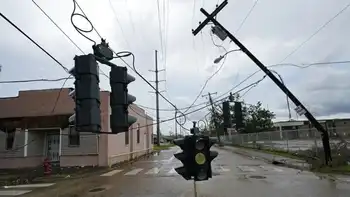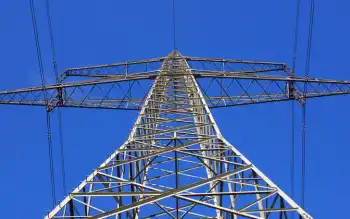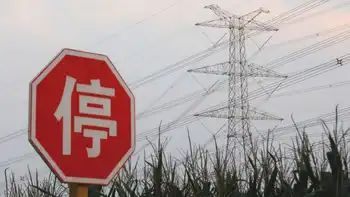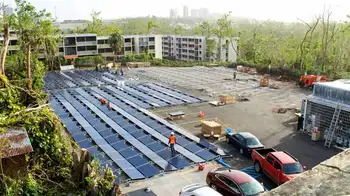Transource Transmission Project Energized In Missouri
CSA Z462 Arc Flash Training - Electrical Safety Essentials
Our customized live online or in‑person group training can be delivered to your staff at your location.

- Live Online
- 6 hours Instructor-led
- Group Training Available
Midwest Transmission Project enhances grid reliability, reduces congestion, and boosts renewable integration across Missouri and Nebraska, linking 345-kV substations in Sibley, Mullin Creek, and Nebraska City within the Southwest Power Pool footprint.
Key Points
A 180-mile, 345-kV line improving reliability, easing congestion, and enabling clean energy across Missouri and Nebraska.
✅ 180-mile 345-kV line linking MO and NE substations
✅ Cuts congestion; improves SPP regional reliability
✅ Enables large-scale renewable energy integration
Columbus, OH - A new transmission project built in Missouri by Transource Missouri LLC now is enhancing reliability and reducing transmission congestion and transmission constraints in the state and region. The 180-mile Midwest Transmission Project was energized Dec. 15.
Transource Missouri LLC is a subsidiary of Transource Energy (Transource), a competitive electric transmission joint venture formed in 2012 by American Electric Power (NYSE: AEP) and Great Plains Energy Incorporated (NYSE: GXP).
The 345-kilovolt (kV) Midwest Transmission Project connects Kansas City Power & Light Company's (KCP&L) Sibley Substation located near Sibley, Mo., with a new transmission substation (Mullin Creek Substation) located south of Maryville, Mo. It then extends to Omaha Public Power District's (OPPD) Substation 3458 located near Nebraska City, Neb. Transource Missouri built and owns approximately 135 miles of the project in Missouri and the new Mullin Creek Substation. Transource Missouri's portion of the project cost was approximately $250 million, as the transformer business sees strategic shifts across the sector.
OPPD built and owns approximately 45 miles of the project in Nebraska.
"This project clearly demonstrates that the combined transmission experience and expertise of AEP and Great Plains Energy allows Transource to develop transmission solutions that successfully balance system requirements, project constructability and costs. This project was a Priority Project in the Southwest Power Pool region and will reduce grid congestion, increase system reliability, provide additional grid capability for future needs and enable large-scale renewable energy development in the region to help meet clean energy demand in New York and New England," said Antonio Smyth, president, Transource Energy.
Transource Missouri built an additional, separate 31-mile, 345-kV transmission project to enhance reliability and relieve grid congestion in northwest Missouri from KCP&L's Iatan substation to the Nashua substation near Smithville. That project was energized in April 2015.
"Transource Energy has been active in other markets, and was recently awarded two competitive transmission projects in the PJM Interconnection – a $72 million transmission upgrade project in West Virginia and a $225 million market efficiency transmission project to address congestion across the Pennsylvania and Maryland border. We continue to pursue competitive transmission opportunities in PJM, the Southwest Power Pool, Midwest ISO and other markets amid declining returns in coal power across the region in order to deliver effective transmission solutions that benefit customers," Smyth said.
AEP owns 86.5 percent of Transource and Great Plains Energy owns 13.5 percent. Transource has offices in Columbus, Ohio and Kansas City, Mo. The members combine more than 100-years of expertise in the planning, design, engineering, construction, and operation of transmission systems.
Headquartered in Kansas City, Mo., Great Plains Energy Incorporated is the holding company of Kansas City Power & Light Company (KCP&L) and KCP&L Greater Missouri Operations Company two of the leading regulated providers of electricity in the Midwest. KCP&L and KCP&L Greater Missouri Operations Company use KCP&L as a brand name.
American Electric Power is one of the largest electric utilities in the United States, delivering electricity and custom energy solutions to nearly 5.4 million customers in 11 states, even as Ohio nuclear generators face new competition from gas-fired capacity. AEP owns the nation's largest electricity transmission system, a more than 40,000-mile network that includes more 765-kilovolt extra-high voltage transmission lines than all other U.S. transmission systems combined. AEP also operates 224,000 miles of distribution lines. AEP ranks among the nation's largest generators of electricity, owning approximately 31,000 megawatts of generating capacity in the U.S. AEP also supplies 3,200 megawatts of renewable energy to customers. AEP's utility units operate as AEP Ohio, AEP Texas, Appalachian Power (in Virginia and West Virginia), AEP Appalachian Power (in Tennessee), Indiana Michigan Power, Kentucky Power, Public Service Company of Oklahoma, and Southwestern Electric Power Company (in Arkansas, Louisiana and east Texas). AEP's headquarters are in Columbus, Ohio.











